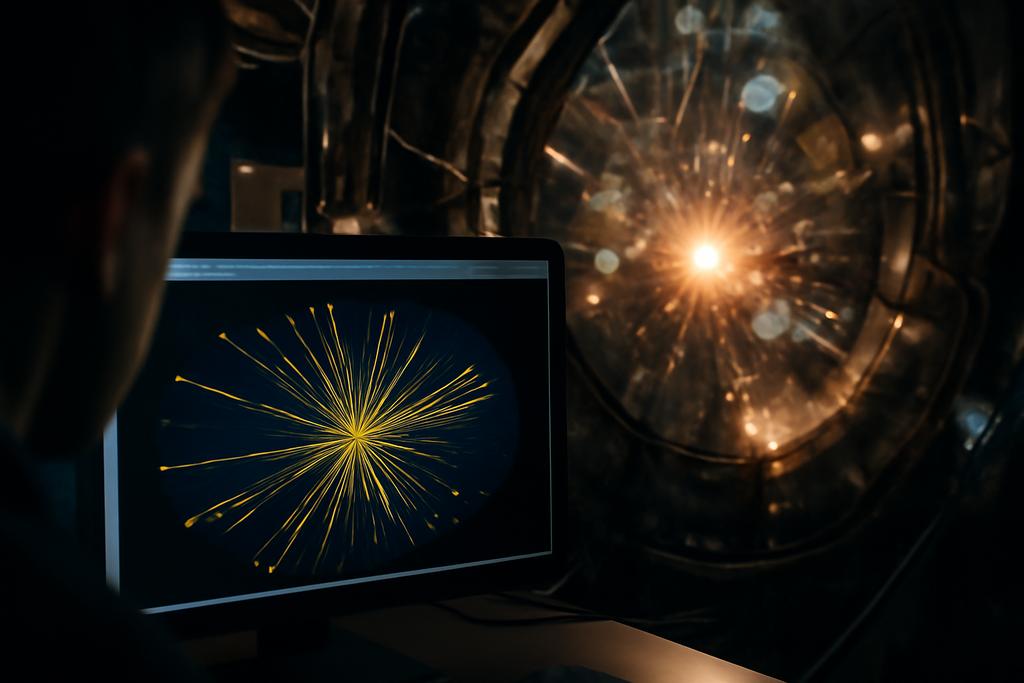Unraveling the Spin Mystery of Strange Particles
In the vast subatomic theater where protons and nuclei collide at near-light speeds, particles emerge in a chaotic dance. Among these are hyperons—particles containing strange quarks—that have long puzzled physicists with their unexpected spin behavior. The LHCb collaboration at CERN has recently taken a fresh look at this enigma by measuring the transverse polarization of Λ and anti-Λ hyperons produced in proton-lead (pPb) collisions at an unprecedented energy of 5.02 TeV per nucleon pair.
Spin, a fundamental quantum property akin to angular momentum, often reveals subtle details about particle interactions. Decades ago, experiments found that Λ hyperons produced in unpolarized proton-proton collisions exhibited a surprising transverse polarization—meaning their spins tended to align perpendicular to the production plane—even though the initial beams were unpolarized. This contradicted early quantum chromodynamics (QCD) predictions, hinting at complex, nonperturbative effects in the strong force that binds quarks together.
Why Polarization Matters More Than You Think
Understanding why and how hyperons become polarized is more than a niche curiosity. It probes the heart of QCD, the theory describing the strong interaction, one of nature’s four fundamental forces. The strong force is notoriously difficult to solve because it becomes intensely nonlinear at low energies, where quarks and gluons form bound states like protons, neutrons, and hyperons. Spin phenomena like transverse polarization offer a rare window into these nonperturbative regimes, helping physicists refine models of hadronization—the process by which quarks transform into observable particles.
Moreover, polarization measurements test theoretical frameworks involving transverse-momentum-dependent fragmentation functions (TMD FFs), which describe how an unpolarized quark can fragment into a polarized hadron. These functions are essential for interpreting spin asymmetries in various collision environments, from electron-positron annihilation to proton-nucleus interactions.
The LHCb Experiment’s Bold New Frontier
The LHCb detector, designed primarily to study beauty quarks, is uniquely positioned to explore hyperon polarization in the forward region of pPb collisions. By analyzing over 200,000 Λ and anti-Λ candidates, the collaboration measured their transverse polarization across a broad range of transverse momenta (0.15 to 6 GeV/c) and Feynman-x values—a variable related to the particle’s momentum along the beam direction.
What makes this measurement stand out is the collision system and energy scale. Previous observations of significant Λ polarization came mostly from proton-proton or fixed-target experiments at lower energies. The pPb collisions at the LHC introduce a heavy nucleus into the mix, creating a more complex environment where nuclear effects could influence polarization. Additionally, the high energy allows probing kinematic regions previously unexplored.
The Surprising Silence of Spin
After meticulous data selection, background subtraction, and efficiency corrections, the LHCb team found that the transverse polarization of both Λ and anti-Λ hyperons is consistent with zero within experimental uncertainties. This null result holds across the measured ranges of transverse momentum and Feynman-x, in both the forward and backward rapidity regions relative to the proton beam.
This outcome is striking because it contrasts with earlier findings of up to 30% polarization in other collision systems. It suggests that the presence of the lead nucleus and the higher collision energy might suppress the mechanisms that generate transverse polarization. Alternatively, it could indicate that the nonperturbative fragmentation effects responsible for polarization behave differently in nuclear environments or at these energies.
What This Means for Our Understanding of the Strong Force
The absence of significant polarization in pPb collisions challenges theorists to revisit their models. It provides valuable constraints on the polarizing fragmentation functions and multiparton correlators that encode spin-momentum correlations in QCD. The results imply that nuclear matter effects and the dynamics of quark-gluon interactions in heavy-ion collisions can wash out the spin asymmetries seen in simpler systems.
In practical terms, these findings help refine the universality and energy dependence of fragmentation functions, essential ingredients for predicting spin phenomena in future experiments, including those planned at the Electron-Ion Collider (EIC). They also underscore the importance of studying a variety of collision systems to disentangle the interplay between initial-state effects, hadronization, and nuclear modifications.
Looking Ahead: The Spin Puzzle Continues
The LHCb collaboration’s work, led by a global team of physicists at CERN, adds a crucial piece to the puzzle of hyperon polarization. While the silence of spin in these high-energy pPb collisions might seem anticlimactic, it opens new questions about how the strange quark’s spin emerges—or fails to emerge—in complex nuclear environments.
Future measurements with increased precision, different collision species, and complementary observables like polarization within jets may reveal subtler effects. As physicists continue to probe the quantum choreography of quarks and gluons, each result—whether a dramatic signal or a quiet null—brings us closer to decoding the rich tapestry of the strong interaction that shapes our universe at its most fundamental level.










